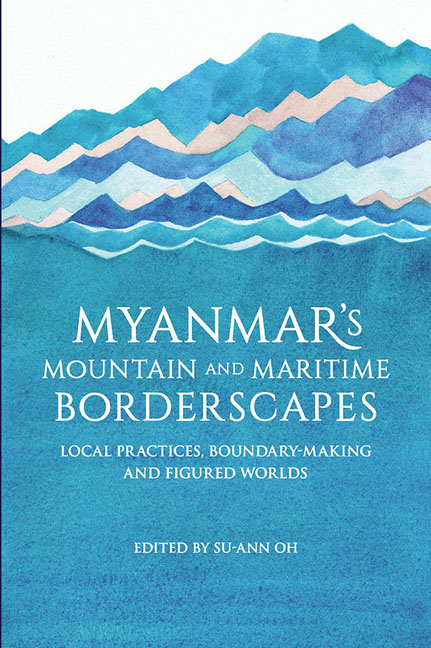Book contents
- Frontmatter
- Contents
- List of Tables
- List of Figures
- Acknowledgements
- Notes on Language, Terminology and Geographical Names
- Contributors
- Abbreviations
- 1 Introduction
- I Overview of Myanmar's Mountain and Maritime Borderscapes
- II Territorial Claims and Imagined Boundaries
- III Social Organization and Border Economies
- IV Mobile Practices and Moving Borders
- V Identity Construction and the Politics of Belonging
- 11 “I Want to Stay Forever in You”
- 12 Life along the Naf Border: Identity Politics of the Rohingya Refugees in Bangladesh
- 13 Home of the Housekeeper: Will Shan Migrants Return after a Decade of Migration?
- 14 Moving on: Spaces of Engagement in the Kayah–Mae Hong Son Borderland
- VI Institutionalized Identity and Border Practices
- Index
13 - Home of the Housekeeper: Will Shan Migrants Return after a Decade of Migration?
from V - Identity Construction and the Politics of Belonging
Published online by Cambridge University Press: 06 June 2017
- Frontmatter
- Contents
- List of Tables
- List of Figures
- Acknowledgements
- Notes on Language, Terminology and Geographical Names
- Contributors
- Abbreviations
- 1 Introduction
- I Overview of Myanmar's Mountain and Maritime Borderscapes
- II Territorial Claims and Imagined Boundaries
- III Social Organization and Border Economies
- IV Mobile Practices and Moving Borders
- V Identity Construction and the Politics of Belonging
- 11 “I Want to Stay Forever in You”
- 12 Life along the Naf Border: Identity Politics of the Rohingya Refugees in Bangladesh
- 13 Home of the Housekeeper: Will Shan Migrants Return after a Decade of Migration?
- 14 Moving on: Spaces of Engagement in the Kayah–Mae Hong Son Borderland
- VI Institutionalized Identity and Border Practices
- Index
Summary
Over the past two decades, economic hardship and political conflict have driven Burmese migrants, refugees and political dissidents across the border from Myanmar into Thailand at an unprecedented scale. According to estimates, the number of Burmese migrant workers in Thailand may have reached about three million whereas the number of Burmese asylum seekers registered with the United Nations High Commissioner for Refugees (UNHCR) approximates 15,000. While the past decades saw a massive flow of Burmese nationals coming across the border into Thailand, in recent years a counter-current has emerged with the return movement of Burmese exiles to Myanmar. This is due to a series of political and economic reforms in Myanmar which began to take place in 2011. A new civilian government has loosened internet restrictions, freed political prisoners and pursued economic reforms to attract more foreign investors. As part of the reforms, in August 2011, Myanmar's president Thein Sein called on all exiles to return. According to government rhetoric, Burmese exiles’ departure to escape persecution by the military resulted in a massive drain that deprived Myanmar of some of its best minds.
As a result, over the past two years, a growing number of Burmese political exiles have returned to their home country. Returnees state the reason for return as “we want to contribute to the country” (Rose 2012; Horn 2012). Cheery Zahau, in her talk about returnees at the Burma Update Conference 2013 at the Australian National University, states that, in the past two years, three types of returnees may be identified: those in armed resistance groups, activists, and immigrants who see opportunities in Myanmar. She notes that all three groups go back because they want to contribute to the country's development (Cheery Zahau 2013).
While an aspect of Burmese exiles returning home has been celebrated in the press as part of the reforms, the question of whether Burmese labour migrants have contemplated return has been largely ignored. In May 2012, the international press (BBC 2012; Whiteman 2012) wrote about Aung San Suu Kyi's visit to Burmese migrants at Mahachai in Thailand, a hub for processing and canning seafood which employs tens of thousands of Burmese workers.
- Type
- Chapter
- Information
- Myanmar's Mountain and Maritime BorderscapesLocal Practices, Boundary-Making and Figured Worlds, pp. 306 - 322Publisher: ISEAS–Yusof Ishak InstitutePrint publication year: 2016

